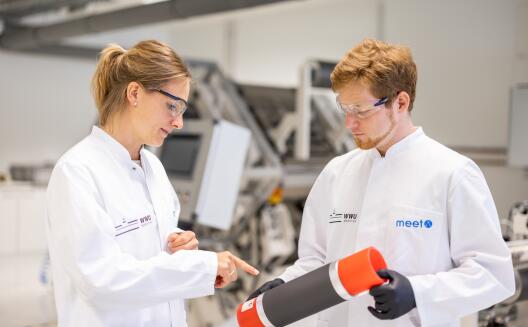Innovative Separator for Chemically Stable Lithium-Air Batteries
Lithium-air batteries are considered a promising technology for next-generation high-energy batteries. Due to their high specific energy density, they are particularly attractive for use in electromobility and stationary energy storage. However, there is still a need for a suitable electrolyte that is chemically stable at both the positive and negative electrode. This challenge is being tackled by the collaborative project “Alternative materials and components for aprotic lithium/oxygen batteries: Chemistry and Stability of Inactive Components” (short: AMaLiS 2.0), in which the Heilbronn-based company IOLITEC Ionic Liquids Technologies, MEET Battery Research Center at the University of Münster, the University of Oldenburg, and the Fraunhofer Institute for Manufacturing Technology and Advanced Materials (IFAM) are bundling their forces. The German Federal Ministry of Education and Research is funding the project over three years with around 1.1 million euros.

Separate Optimization of the Electrolyte for Anode and Cathode
So far, research has scarcely considered the inactive materials in lithium-air batteries. To increase the stability of this type of batteries, the research team is therefore focusing on both the separator and the electrolyte, which physically separate and electrically isolate the two electrodes in the cell. In lithium-air batteries, one electrode is made of metallic lithium, while the other – the gas diffusion electrode – is made of a porous network and conducting material on which oxygen (O2) from the air is reduced. “We are testing a separator coated on both sides to significantly expand the range of possible electrolytes for lithium-air batteries. For this purpose, we are separately optimizing the coating for the lithium electrode on one side and for the gas diffusion electrode on the other,” says MEET scientist Verena Küpers.
Together with the team from IOLITEC, the MEET scientists are further developing the separator designed at MEET. For this, the researchers are testing different separator coatings that are specifically adapted to the challenges of the respective electrode. Suitable ionic liquids are used to improve the interfacial stability. The team from the University of Oldenburg is investigating the processes on the surface of the separator and the electrodes using various methods, including surface spectroscopy and electrochemical scanning microscopy (SECM). At Fraunhofer IFAM, the researchers are producing a novel gas diffusion electrode from nanostructured titanium carbide. By combining it with a specific membrane, it is designed to prevent the penetration of parasitic air components such as carbon dioxide or water vapor into the cell.
Focus on Scalability of the Results
Another aim of the collaborative project is to demonstrate the scalability of the results obtained. For this purpose, a flat cell with an area of 25 square centimeters is being built. In a first step, this cell should demonstrate that a stable, rechargeable overall system is achievable. At the same time, it provides the foundation for further research.

